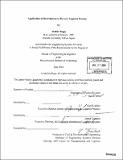| dc.contributor.advisor | Chris Caplice. | en_US |
| dc.contributor.author | Kaga, Akihiro, 1975- | en_US |
| dc.contributor.other | Massachusetts Institute of Technology. Engineering Systems Division. | en_US |
| dc.date.accessioned | 2005-11-03T16:50:53Z | |
| dc.date.available | 2005-11-03T16:50:53Z | |
| dc.date.issued | 2004 | en_US |
| dc.identifier.uri | http://hdl.handle.net/1721.1/29525 | |
| dc.description | Thesis (M. Eng. in Logistics)--Massachusetts Institute of Technology, Engineering Systems Division, 2004. | en_US |
| dc.description | "June 2004." | en_US |
| dc.description | Includes bibliographical references (leaves 104-106). | en_US |
| dc.description.abstract | In this thesis, real options are used to identify the optimal model for the reverse logistics process of a technology company in the circuit board business. Currently, customers return defective boards and the company repairs the boards and sends them back. Now that the new product cost is falling below the level of the repair cost, the company is considering an alternative operational model, which is to scrap the returned boards and swap them with new products. As the product cost declines, it is also widely fluctuating, and it is this fluctuation that makes the switching option between the repair and swap model valuable. The repair and swap models (with and without switching options) will each produce different cost saving amounts with different degrees of risk. As a result of real options analysis, the swap model with the switching option to repair is determined to be optimal and has only modest risk. Specifically, the costs would be reduced by $1.3 million (of which $0.9 million is the option value) and by 18% compared to the costs under the current model, and the volatility will only moderately increase from 8% to 11%. However, it should be noted that the model is sensitive to both volatility and switching cost. Unlike the traditional methodologies, such as optimization or discounted cash flow analysis, real options quantifies the option value as well as the risk and hence shows the maximum investment necessary to obtain the option. That being said, in this thesis, optimization (the news vendor approach), simulation (Monte Carlo simulation), and discounted cash flow analysis take complementary roles to real options analysis. The option value is significant when the key uncertainties (e.g., the product cost, repair cost, and volume) are volatile | en_US |
| dc.description.abstract | (cont.) because the option allows businesses to capture upside opportunities while protecting them from downside risks. | en_US |
| dc.description.statementofresponsibility | by Akihiro Kaga. | en_US |
| dc.format.extent | 106 leaves | en_US |
| dc.format.extent | 5188302 bytes | |
| dc.format.extent | 5201078 bytes | |
| dc.format.mimetype | application/pdf | |
| dc.format.mimetype | application/pdf | |
| dc.language.iso | eng | en_US |
| dc.publisher | Massachusetts Institute of Technology | en_US |
| dc.rights | M.I.T. theses are protected by copyright. They may be viewed from this source for any purpose, but reproduction or distribution in any format is prohibited without written permission. See provided URL for inquiries about permission. | en_US |
| dc.rights.uri | http://dspace.mit.edu/handle/1721.1/7582 | |
| dc.subject | Engineering Systems Division. | en_US |
| dc.title | Application of real options to reverse logistics process | en_US |
| dc.type | Thesis | en_US |
| dc.description.degree | M.Eng.in Logistics | en_US |
| dc.contributor.department | Massachusetts Institute of Technology. Engineering Systems Division | |
| dc.identifier.oclc | 57341572 | en_US |
